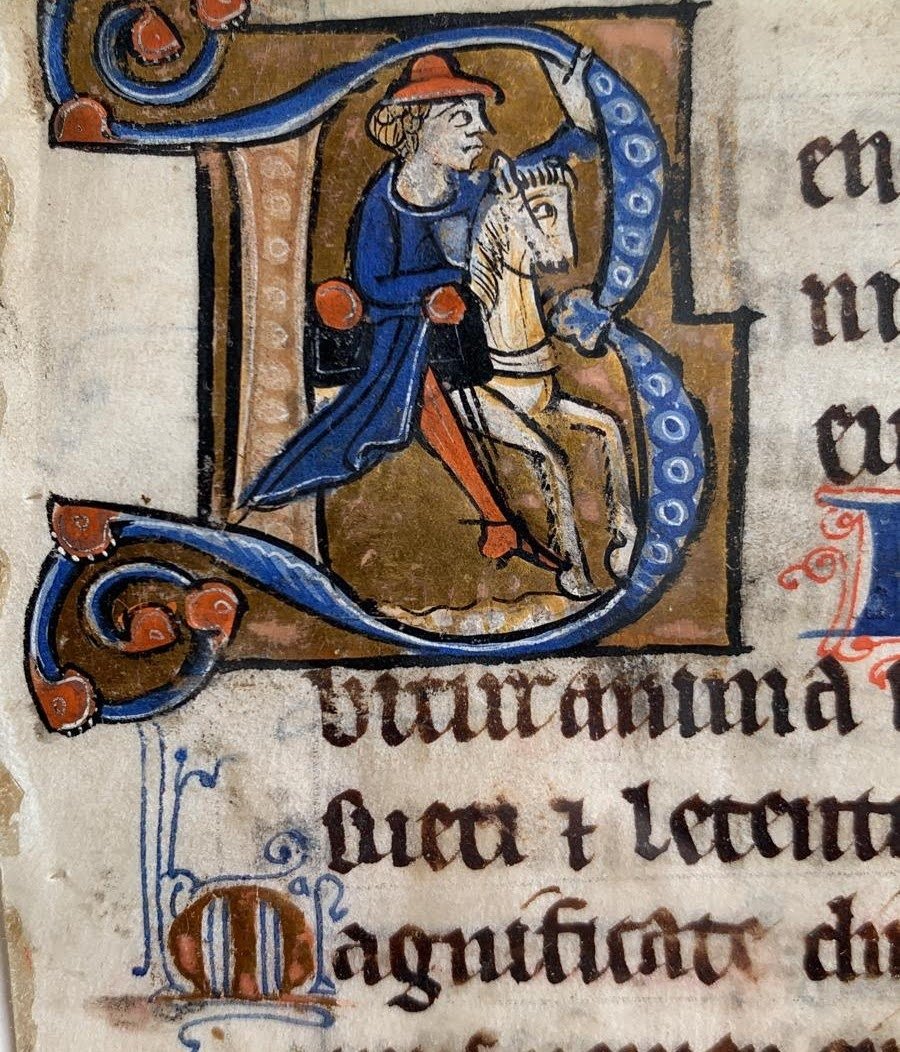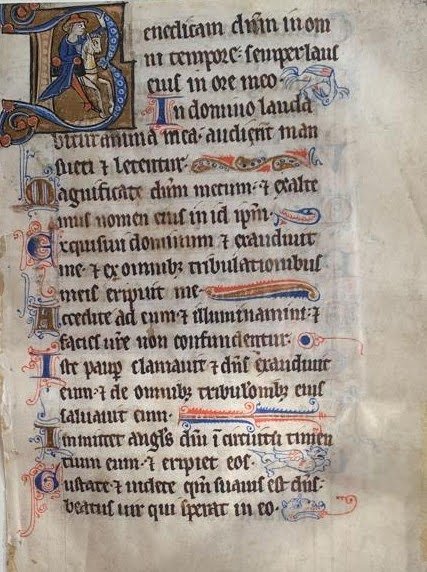 Image 1 of 3
Image 1 of 3

 Image 2 of 3
Image 2 of 3

 Image 3 of 3
Image 3 of 3




Beautifully historiated leaf from a Southern Netherlandish Psalter-Hours, with an unusual initial of a horseman in a wonderfully flowing decorated gilded letter B.
[13TH CENTURY HISTORIATED MANUSCRIPT]
Beautifully historiated leaf from a Southern Netherlandish Psalter-Hours, with an unusual initial of a horseman in a wonderfully flowing decorated gilded letter B.
c.1260
(c. 177 x 135 mm). Psalm 33:1 - 18; folio 72 from what would have been a manuscript with - at the time - almost no parallel. Manuscript on vellum, 20 lines, rubricated in red and blue, decorative line-fillers in between verses, numerous fantastical/animal creatures as decoration, including a bird, griffin, fish, and anthropomorphic figures, large historiated initial of a horseman on a gold background. A little flaking of white pigment in the initial, vestiges of mounting-tape to edges, some overall wear, framed and glazed.
Provenance: likely made for a Benedictine nun or abbess (given textual references to “the community of this holy monastery” and to the Virgin and St Benedict, as well as to “our abbess”; the manuscript was broken up by 1966, when leaves were in the possession of Carl Richartz of Amsterdam (d. 1983); Sam Fogg in London; private collection in Belgium from 2001.
PSALM 33 IN AN UNUSUAL AND CHARMING SURVIVAL of a very early Psalter-hours that once must have been EXTRAORDINARILY LAVISH and made for a very wealthy female patron, possibly even royal (cf. Peter Kidd's writings on this in his catalogue of the Robert McCarthy collection). There has been much scholarly interest, and much invaluable work by Peter Kidd, in the parent manuscript and much debate about its origins. The variety (but not the style of the decoration, or the style of the initials) suggest England, and the fact that Psalms 51 and 101 are treated as major divisions also suggest that it was produced within a sphere of English or German influence. However, the consensus at the moment appears to be Flanders or the Rhineland. The original manuscript would have contained the Psalms, Hours of the Virgin and Office of the Dead, and would have had a historiated initial for every psalm, prayer, hymn, canticle, and so on: this is exceptionally rare. These initials are very large (being four-line initials where one-line initials would be expected) and the parent manuscript would have had up to 30 or 40 full-page miniatures. The depiction of the rider in an initial, as here, is unusual in itself. Other leaves from the same manuscript, which was broken up by the second half of the 20th century, feature in illustrious collections - for instance the Robert McCarthy collection, and that of the Cleveland Museum of Art (3 ll.). Many of the leaves were sold by Sotheby's in 1983 from the Chicago collection of Esther Rosenbaum (and the mss. has resultingly sometimes been called "the Rosenbaum Psalter"). Sotheby's did a rescension of all known leaves in 2015, recording a total of more than 40 known, 28 from the Psalter section (including this one).
A FASCINATING AND CHARMING SURVIVAL OF A MANUSCRIPT OF UNPARALELLED LAVISHNESS MADE FOR A 13TH CENTURY FEMALE PATRON WITH AN UNUSUAL HISTORIATED INITIAL OF A RIDER.
cf. Peter Kidd, The McCarthy Collection, vol. II, no. 20 (pp. 106-109) and “A Lavishly Illuminated 13th-Century Psalter-Hours Made for a Nun (I and II),” Manuscripts Provenance, online, 2019; as well as item 8c in the exhibition Andachtsbücher des Mittelalters aus Privatbesitz, Schnütgen Museum, Cologne, 1987.
[13TH CENTURY HISTORIATED MANUSCRIPT]
Beautifully historiated leaf from a Southern Netherlandish Psalter-Hours, with an unusual initial of a horseman in a wonderfully flowing decorated gilded letter B.
c.1260
(c. 177 x 135 mm). Psalm 33:1 - 18; folio 72 from what would have been a manuscript with - at the time - almost no parallel. Manuscript on vellum, 20 lines, rubricated in red and blue, decorative line-fillers in between verses, numerous fantastical/animal creatures as decoration, including a bird, griffin, fish, and anthropomorphic figures, large historiated initial of a horseman on a gold background. A little flaking of white pigment in the initial, vestiges of mounting-tape to edges, some overall wear, framed and glazed.
Provenance: likely made for a Benedictine nun or abbess (given textual references to “the community of this holy monastery” and to the Virgin and St Benedict, as well as to “our abbess”; the manuscript was broken up by 1966, when leaves were in the possession of Carl Richartz of Amsterdam (d. 1983); Sam Fogg in London; private collection in Belgium from 2001.
PSALM 33 IN AN UNUSUAL AND CHARMING SURVIVAL of a very early Psalter-hours that once must have been EXTRAORDINARILY LAVISH and made for a very wealthy female patron, possibly even royal (cf. Peter Kidd's writings on this in his catalogue of the Robert McCarthy collection). There has been much scholarly interest, and much invaluable work by Peter Kidd, in the parent manuscript and much debate about its origins. The variety (but not the style of the decoration, or the style of the initials) suggest England, and the fact that Psalms 51 and 101 are treated as major divisions also suggest that it was produced within a sphere of English or German influence. However, the consensus at the moment appears to be Flanders or the Rhineland. The original manuscript would have contained the Psalms, Hours of the Virgin and Office of the Dead, and would have had a historiated initial for every psalm, prayer, hymn, canticle, and so on: this is exceptionally rare. These initials are very large (being four-line initials where one-line initials would be expected) and the parent manuscript would have had up to 30 or 40 full-page miniatures. The depiction of the rider in an initial, as here, is unusual in itself. Other leaves from the same manuscript, which was broken up by the second half of the 20th century, feature in illustrious collections - for instance the Robert McCarthy collection, and that of the Cleveland Museum of Art (3 ll.). Many of the leaves were sold by Sotheby's in 1983 from the Chicago collection of Esther Rosenbaum (and the mss. has resultingly sometimes been called "the Rosenbaum Psalter"). Sotheby's did a rescension of all known leaves in 2015, recording a total of more than 40 known, 28 from the Psalter section (including this one).
A FASCINATING AND CHARMING SURVIVAL OF A MANUSCRIPT OF UNPARALELLED LAVISHNESS MADE FOR A 13TH CENTURY FEMALE PATRON WITH AN UNUSUAL HISTORIATED INITIAL OF A RIDER.
cf. Peter Kidd, The McCarthy Collection, vol. II, no. 20 (pp. 106-109) and “A Lavishly Illuminated 13th-Century Psalter-Hours Made for a Nun (I and II),” Manuscripts Provenance, online, 2019; as well as item 8c in the exhibition Andachtsbücher des Mittelalters aus Privatbesitz, Schnütgen Museum, Cologne, 1987.
[13TH CENTURY HISTORIATED MANUSCRIPT]
Beautifully historiated leaf from a Southern Netherlandish Psalter-Hours, with an unusual initial of a horseman in a wonderfully flowing decorated gilded letter B.
c.1260
(c. 177 x 135 mm). Psalm 33:1 - 18; folio 72 from what would have been a manuscript with - at the time - almost no parallel. Manuscript on vellum, 20 lines, rubricated in red and blue, decorative line-fillers in between verses, numerous fantastical/animal creatures as decoration, including a bird, griffin, fish, and anthropomorphic figures, large historiated initial of a horseman on a gold background. A little flaking of white pigment in the initial, vestiges of mounting-tape to edges, some overall wear, framed and glazed.
Provenance: likely made for a Benedictine nun or abbess (given textual references to “the community of this holy monastery” and to the Virgin and St Benedict, as well as to “our abbess”; the manuscript was broken up by 1966, when leaves were in the possession of Carl Richartz of Amsterdam (d. 1983); Sam Fogg in London; private collection in Belgium from 2001.
PSALM 33 IN AN UNUSUAL AND CHARMING SURVIVAL of a very early Psalter-hours that once must have been EXTRAORDINARILY LAVISH and made for a very wealthy female patron, possibly even royal (cf. Peter Kidd's writings on this in his catalogue of the Robert McCarthy collection). There has been much scholarly interest, and much invaluable work by Peter Kidd, in the parent manuscript and much debate about its origins. The variety (but not the style of the decoration, or the style of the initials) suggest England, and the fact that Psalms 51 and 101 are treated as major divisions also suggest that it was produced within a sphere of English or German influence. However, the consensus at the moment appears to be Flanders or the Rhineland. The original manuscript would have contained the Psalms, Hours of the Virgin and Office of the Dead, and would have had a historiated initial for every psalm, prayer, hymn, canticle, and so on: this is exceptionally rare. These initials are very large (being four-line initials where one-line initials would be expected) and the parent manuscript would have had up to 30 or 40 full-page miniatures. The depiction of the rider in an initial, as here, is unusual in itself. Other leaves from the same manuscript, which was broken up by the second half of the 20th century, feature in illustrious collections - for instance the Robert McCarthy collection, and that of the Cleveland Museum of Art (3 ll.). Many of the leaves were sold by Sotheby's in 1983 from the Chicago collection of Esther Rosenbaum (and the mss. has resultingly sometimes been called "the Rosenbaum Psalter"). Sotheby's did a rescension of all known leaves in 2015, recording a total of more than 40 known, 28 from the Psalter section (including this one).
A FASCINATING AND CHARMING SURVIVAL OF A MANUSCRIPT OF UNPARALELLED LAVISHNESS MADE FOR A 13TH CENTURY FEMALE PATRON WITH AN UNUSUAL HISTORIATED INITIAL OF A RIDER.
cf. Peter Kidd, The McCarthy Collection, vol. II, no. 20 (pp. 106-109) and “A Lavishly Illuminated 13th-Century Psalter-Hours Made for a Nun (I and II),” Manuscripts Provenance, online, 2019; as well as item 8c in the exhibition Andachtsbücher des Mittelalters aus Privatbesitz, Schnütgen Museum, Cologne, 1987.

